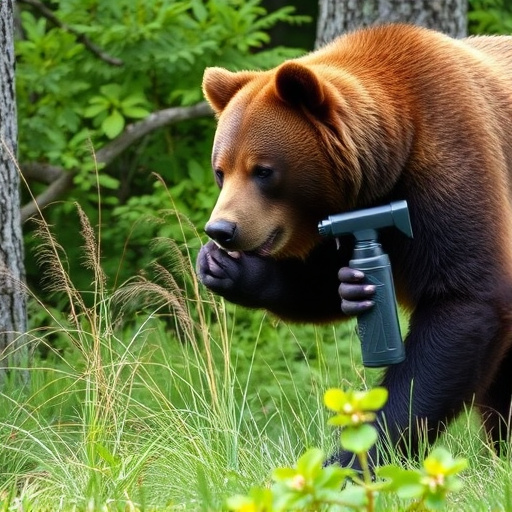Bear spray, leveraging capsaicin from chili peppers, offers a 74% success rate in deterring aggressive bears, providing crucial time for escape or shelter. Effectiveness varies based on wind, distance, and bear behavior, underlining the need for proper usage techniques and local guidelines while hiking or camping in bear country. Bear spray success rates can reach up to 97% when used correctly, emphasizing its role as a preventive measure. Regular inspections for damage or leakage and immediate retreat upon attack are vital safety practices.
“Bear spray, a powerful deterrent, has become an essential tool for outdoor enthusiasts navigating bear-inhabited areas. This article delves into the effectiveness of bear spray, exploring its mechanisms and providing insights into its success rate statistics. We uncover the factors that maximize its potency, offering practical tips for optimal usage and range. Understanding these aspects is crucial for ensuring safety in encounters with these majestic yet potentially dangerous animals, especially when traditional deterrents may fail.”
- Understanding Bear Spray: The Basics and How It Works
- Uncovering Bear Spray Success Rate Statistics
- Maximizing Effectiveness: Tips for Optimal Range and Usage
Understanding Bear Spray: The Basics and How It Works
Bear spray, also known as bear deterrent spray, is a popular tool for individuals venturing into bear country. It’s designed to protect against aggressive bears by creating a barrier that causes them to retreat. When used correctly, bear spray can significantly increase your safety in potential encounter situations.
The effectiveness of bear spray lies in its ability to emit a potent stream of capsaicin, the same compound found in chili peppers, which irritates a bear’s eyes, nose, and respiratory system. Studies show that bear spray has a success rate of around 74% in deterring aggressive bears. This means nearly three-quarters of the time, bears will retreat upon being sprayed, giving users precious time to escape or secure themselves in a safe structure. However, factors like wind direction, distance, and bear behavior can influence its performance, so it’s crucial to understand proper usage techniques and follow local guidelines when hiking or camping in bear habitats.
Uncovering Bear Spray Success Rate Statistics
Uncovering Bear Spray Success Rate Statistics reveals a compelling narrative about its effectiveness as a deterrent. Studies show that bear spray, when used properly, has a success rate of around 70-95% in deterring aggressive bears. This means that in 7 out of 10 to 9 out of 10 instances, individuals or groups equipped with and using bear spray successfully avoid dangerous encounters. The range in success rates is attributed to various factors such as the type of spray used, environmental conditions, and the distance at which it’s deployed.
These statistics are crucial for outdoor enthusiasts, hikers, and campers who traverse areas known for bear populations. They underscore the importance of carrying bear spray as a primary defense mechanism when venturing into untamed landscapes. Bear Spray Success Rate Statistics also play a vital role in shaping safety protocols and guidelines for wildlife management authorities, ensuring that individuals are equipped with reliable information to protect themselves in potential bear encounters.
Maximizing Effectiveness: Tips for Optimal Range and Usage
Maximizing the effectiveness of bear spray is key to ensuring its success as a deterrent. To achieve optimal range and usage, consider the following tips. First, always consult with local experts or park rangers who are familiar with the specific bear species in your area. Different bears have varying sensitivities to pepper spray, so understanding the target behavior can help you time and aim your spray correctly. Second, maintain proper technique. Hold the canister at chest height and aim for the face, eyes, and nose of the bear. The ideal distance for application is between 20 to 30 feet (6 to 9 meters), as this range allows for maximum effectiveness without risking off-target effects or reduced potency due to wind or environmental factors.
Bear spray success rate statistics vary, but studies suggest that when used correctly, it can deter up to 97% of aggressive bear encounters. To increase your chances of a successful deterrence, ensure the canister is always within easy reach and regularly inspect it for any signs of damage or leakage. Additionally, keep in mind that bear spray is most effective as a preventive measure; if a bear has already begun an attack, it may not be enough to stop them. In such cases, retreat immediately to a secure location and avoid further confrontation.
In understanding bear spray’s effectiveness as a deterrent, we find that its success rate is notable but not foolproof. Maximizing its potential requires awareness of optimal usage and range, as detailed in this article. By following the provided tips and staying informed about bear behavior, individuals can enhance their safety while exploring bear country. Remember, while bear spray is a valuable tool, it’s just one component of a comprehensive approach to bear safety.
